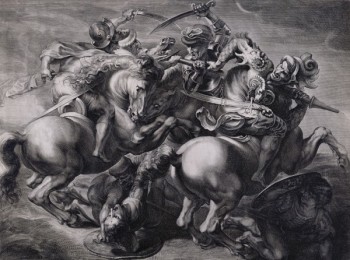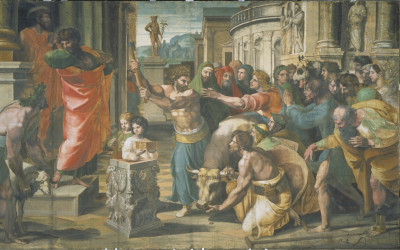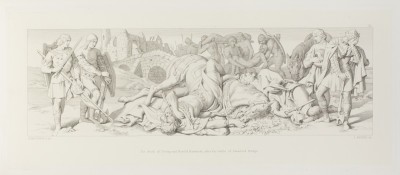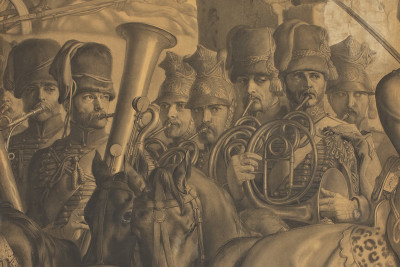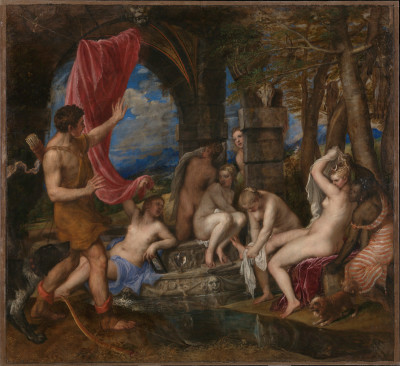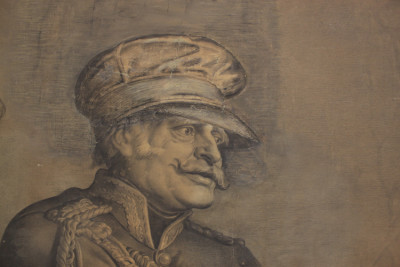Daniel Maclise: The Waterloo Cartoon
Daniel Maclise’s cartoon for ‘The Meeting of Wellington and Blücher’ is a preparatory drawing on an epic scale.
To coincide with the 200th anniversary of the Battle of Waterloo a rarely exhibited treasure of the RA’s Collection, the Daniel Maclise cartoon, The Meeting of Wellington and Blücher after the Battle of Waterloo, will be on display after spending decades in storage.
Over 13 metres wide, it is one of the largest cartoons in the UK and was produced in preparation for a prestigious commission in the Houses of Parliament, where the the finished wall-painting is still on display. A work of monumental scale and drama it depicts one of the most significant battles in British history in incredible detail.
Maclise was a prolific painter and illustrator who was much admired for his draughtsmanship and his outstanding skill is showcased in the Waterloo Cartoon. Completed from 1858–1859 he used extensive research and eye-witness accounts to inform the work. Remarkably the piece does not portray triumphalism or glorify war, instead highlighting the tragedy and suffering of this ferocious battle.
The cartoon has recently undergone conservation treatment, thanks to funding from the Arts Council England, to allow it to be presented during this significant occasion.
The Waterloo Cartoon can also be seen for the first time in 40 years, on loan, at the Royal Armouries in Leeds as part of the Waterloo 1815: The Art of Battle exhibition from 23 May until 23 August before returning to the RA.
2 September 2015 — 3 January 2016
Saturday – Thursday 10am – 6pm
Friday 10am – 10pm
Christmas closures
Please note that the RA will be closed on the 24, 25, and 26 December 2015. On Friday 1 January 2016, the gallery will be open from 12 – 6pm.
Complimentary entry with a valid Royal Academy exhibition ticket or £3 General Admission ticket. Friends of the RA go free.
Weston Rooms, Burlington House, Royal Academy of Arts
-
Explore the Waterloo Cartoon
-
Daniel Maclise RA, The Meeting of Wellington and Blücher after the Battle of Waterloo, 1861. Water-glass wall painting. 285.8 × 3535.7 cm. House of Lords, Palace of Westminster, London. Parliamentary Art Collection.
-
Listen
An Introduction to 'Daniel Maclise: The Waterloo Cartoon'
In this podcast, RA curator Annette Wickham explores the story behind this epic drawing by Daniel Maclise, and considers why such a remarkable work has been hidden from public view for almost a century.
-
-

The Waterloo Cartoon
Shop
Discover the story behind Maclise’s epic work – from its creation to the reasons behind its being hidden for so long – in this concise but comprehensive volume by Annette Wickham. Also in the volume, military expert Mark Murray-Flutter guides readers through the characters, equipment and arms portrayed in each scene.
The book also includes a colour fold-out of The Meeting of Wellington and Blücher after the Battle of Waterloo, and is a fascinating read for both art and military enthusiasts alike.
-
-
Warfare and conflict in the RA Collection
-

Cast of the Borghese Gladiator
Maclise’s Cartoon isn’t the only work we hold which looks at how artists represent the horror – and glory – of war. Here are eight pieces, ranging from the Classical era to the 20th Century, which shed some light on the history of art and battle.
The Borghese Gladiator is one of the most celebrated examples of Classical sculpture. A plaster cast of the figure, with its distinctive pose of a fighting gladiator, was drawn by generations of students at the Royal Academy Schools. Daniel Maclise attended the Schools from 1828 and won medals for his drawings of the casts.
-

Print after Leonardo da Vinci’s Battle of Anghiari
Battle scenes were popular subjects in Renaissance art. This dramatic print shows a group of men on horseback in a furious battle over the possession of a standard and is after a famous lost painting by Leonardo da Vinci.
-

Entry of the French into Milan, 15 May 1796
Andrea Appiani was an official artist to Napoleon. This print is after one of a cycle of frescoes that he painted in the Palazzo Reale, Milan, celebrating Napoleon’s successes. This scene shows Napoleon at the head of his army as they enter Milan after a victory over the Austrians. The imagery used by Appiani relies on Classical depictions of triumphal processions.
-
-
-

Infanterie Ecossaise
After the Battle of Waterloo in 1815, British and Allied troops occupied Paris. The uniforms of soldiers from Scottish Highland regiments, as shown here, were a particular novelty and provided subject matter for numerous caricatures.
-

The Disasters of War
This shocking scene is from Goya’s series The Disasters of War or, as he himself described it, ‘Fatal consequences of Spain’s bloody war with Bonaparte, and other emphatic caprices’. Rejecting romanticised depictions of heroic victories entirely, Goya instead revealed the atrocities and horrors of war. The title of this graphic image of mutilated corpses translates as ‘A heroic feat! With dead men!’.
-

The Battle of Hyderabad
George Jones’s diploma painting depicts the battle that took place between British forces and the Emirs of Sindh near Hyderabad in Pakistan in March 1843. Jones made a career from battle painting after having served in the Duke of Wellington’s army in the Peninsular Wars. Coincidentally, he bore a strong resemblance to the Duke and was known as ‘Waterloo’ Jones.
-
-
-

Henry the Sixth, King of England
This colourful depiction of King Henry VIth (1421-1471) on horseback comes from an important illustrated book on armour by Samuel Meyrick. This publication was used by Victorian artists as source material in creating scenes of medieval pageantry and warfare.
-

The Death of Napoleon Bonaparte
This illustration from a French childrens’ book published in the late 19th century depicts Napoleon ‘ascending to glory’ as his eagle dies. By this time, Napoleon was an historical figure of great fascination who was frequently depicted in both British and French art.
-

Sgt. Bert Bowers
This portrait of a Chelsea Pensioner was painted in 1991 but the depiction of an old soldier also has resonance with 18th-century ‘fancy’ pictures. The experience and hardship of a soldier’s life was believed to be etched on their face, and artists often transformed into ancient prophets or patriarchs in historical subjects. Bowers has a strong presence with his red uniform and intense gaze.
-



